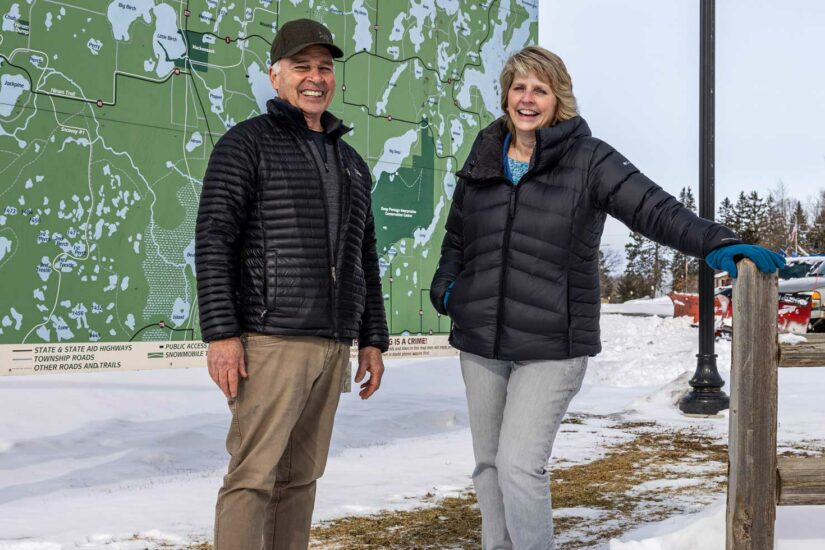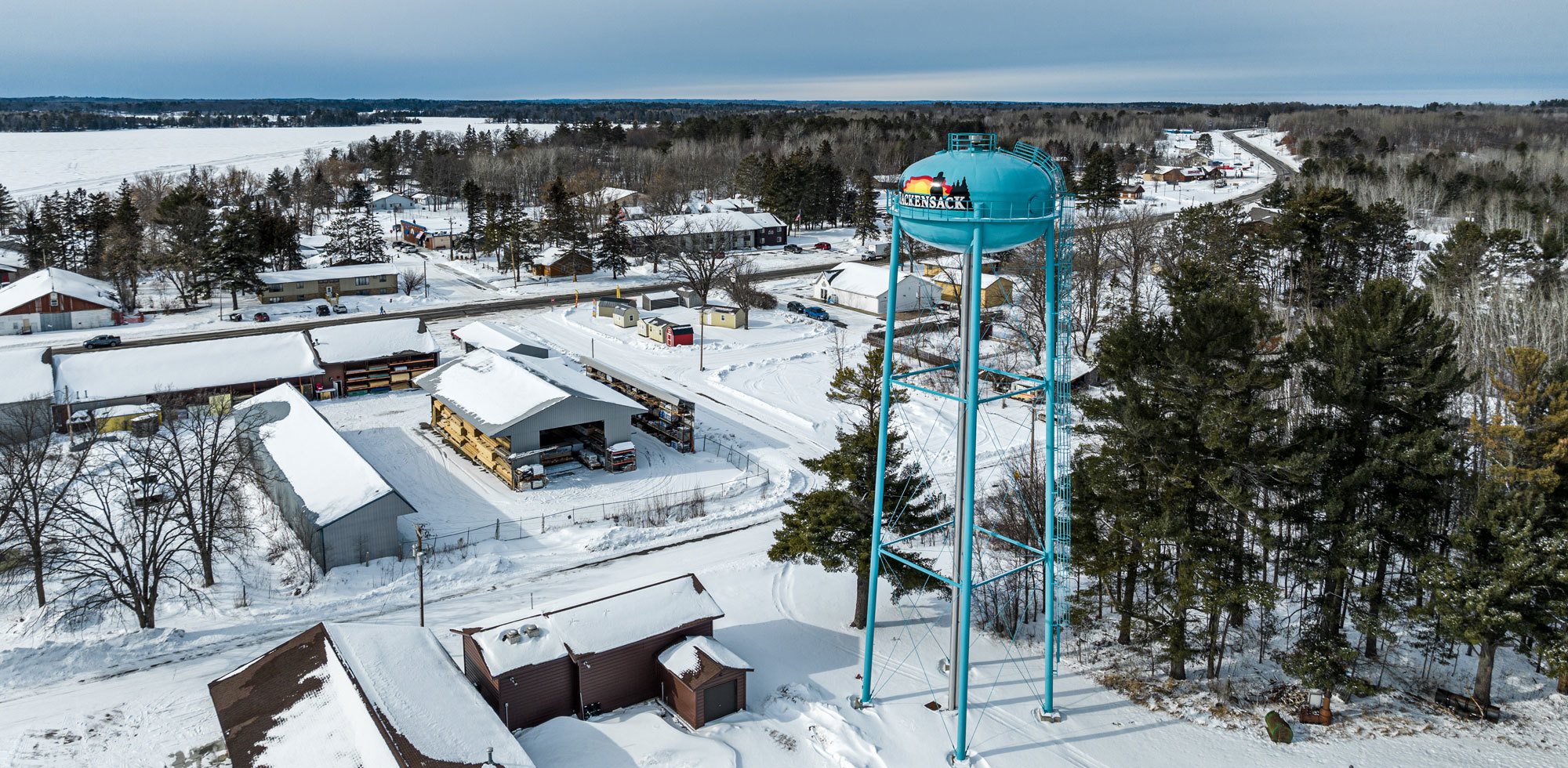
A Place to Call Home
Communities at a crossroads: How can we create affordable housing to grow and prosper?
By Gene Rebeck | Photography by John Linn
Mann Lake Bee & Ag Supply in Hackensack has been abuzz with activity. “We are on a hiring spree,” said Shana Rowlette, Mann Lake’s chief financial officer. As of late January, the international distributor of beekeeping supplies was in the process of bringing on 53 people, raising the company’s total headcount to nearly 200. The business has an additional 46 openings in manufacturing, shipping, sales and management. As the pandemic eases, beekeepers are in growth mode, “which means they’re coming to us to buy a lot of product,” Rowlette said.
High demand typically translates to business success, but Mann Lake is finding it challenging to sustain its growth. The reason: In a not-so-densely populated area, it’s hard to find employees. Hackensack, located in Cass County just south of Leech Lake, is a small town (population 291) in the midst of a housing crisis. There are numerous seasonal residents with cabins and second homes thanks to an abundance of lakes in the area. That augments local spending and the local tax base, but it also feeds a larger challenge: a pronounced lack of starter homes, apartments, and other housing that potential employees can afford.
“We’re tapping the market an hour away,” Rowlette said. “But a lot of people don’t want to drive an hour to work.” The shortage of affordable housing also means it’s difficult to attract needed talent willing to relocate.
There are signs that working-age people and their families want to move to areas like Hackensack. The Mankato-based Center for Rural Policy and Development noted in its State of Rural 2023 report, released in January, that rural Minnesota counties as a whole gained population in 2020 and 2021 following a decades-long trend of population loss. So what can places like Hackensack do to help people move there—and to help employers like Mann Lake hire the people they need?
A Growing Shortage
“I think affordable housing has always been a big challenge for the region,” said Deanna Hemmesch, executive director of the Central Minnesota Housing Partnership (CMHP), a St. Cloud-based nonprofit that develops affordable housing throughout a 16-county area. “But recently, it feels to me that it’s gotten worse. We’re getting more and more requests for additional housing and [questions about] how we can help.
Founded 30 years ago, CMHP now owns and manages 35 affordable rental properties comprising more than 900 units. The nonprofit also writes proposals to help regional communities obtain and administer grants from the state’s Small Cities Development Program. Municipalities can use these funds to renovate single-family homes and rental properties.
Still, for all that CMHP and other organizations have accomplished, the demand for affordable housing continues to rise. “Every county we cover has a large population of people who are cost-burdened—who are paying more than 30 percent of their income for rent or for any sort of housing,” Hemmesch said. It’s no longer just an urban issue. “Everyone is struggling to find places to house the people who work in their community.”
Why can’t the need be filled? One factor: Construction material prices have gone up 33 percent since the onset of the pandemic, according to the National Association of Home Builders. Fewer projects are being financed “because the funds don’t go as far as they used to go,” Hemmesch noted. In addition, there aren’t enough subcontractors to handle projects that do receive funding. “Sometimes they don’t want to work on these projects because there are additional requirements, such as prevailing wages and additional paperwork,” she said.
The price of existing housing stock also has climbed. According to the Baxter-based Greater Lakes REALTORS® Association, the median house price in the association’s region is up nearly 24 percent during the past two years.
The uptick has caught the attention of nonprofits that typically don’t focus on housing, said Zach Tabatt, nonprofit development program officer for the Initiative Foundation. “We started to see a spike in the number of nonprofits requesting information about housing and affordability,” he said. “We wanted to be part of the solution, and that’s what led us to co-convene a December housing summit in Mille Lacs to discuss possible solutions.”
According to Ben Winchester, a rural sociologist and a University of Minnesota Extension research fellow, one potential solution involves the aging homeowner base in rural communities. Since 1950, Winchester’s research found, rural populations have declined but the housing stock has remained steady. Why? Not so long ago, seniors typically moved out of their homes once their nests were empty. These days, they’re staying longer, whether due to economic forces or encouragement from age-in-place programs established over the past couple of decades. “That inhibits the ability for people to move on and for younger people to move in,” Winchester said. In other words, it keeps a lot of houses off the market that could be occupied by working families.
Adding to the challenge: Seniors who stay longer often don’t have the energy or resources to adequately maintain their homes. And that can result in houses that require a steep investment to modernize and bring up to code—a particular challenge for those who might be participating in first-time homebuyer programs.
“For me, the way forward on workforce housing is to develop senior residences,” Winchester said. His belief: “We have no shortage of workforce housing in our rural communities. It’s just currently being occupied by the wrong people.” While not a popular topic, he said, it’s one that should be addressed in community housing conversations.
What can be done?
At the December housing summit, one for-profit business proposed pre-built accessory dwelling units—self-contained apartments, cottages or small residential homes on the same property as a main single-family home, duplex or other residential unit—to maximize living space. Another popular idea was the creation of patio homes that can be built in clusters to maximize smaller lot sizes.
The state has several long-standing programs that attempt to drive solutions, but they generally are underfunded and hard to access in Greater Minnesota. “Communities like Crow Wing County have started local housing trust funds, and towns like Hackensack are considering the possibility,” Tabatt said. “These trust funds can help spur development through local funding streams and local decision-making. In general, many entities in the region are looking for new and creative ways to get more housing built.”
Some local governments are finding success. The cities of Mora and North Branch, for instance, have put together funding partnerships that have allowed both communities to accelerate the construction of affordable living units. Further north, Otter Tail County has established a program called The Big Build, the goal of which is to build, preserve or rehabilitate 5,000 housing units by 2025.
Taking Action in Hackensack
Hackensack has been taking an active role in attracting new housing. About four years ago, the Initiative Foundation helped community members establish the Hackensack Lakes Area Community Foundation, which covers nine townships and includes the neighboring town of Backus. Supporters then created the Hackensack Game Changers—a series of teams focused on community betterment projects.
Kristine Biessener, an agent with the Hackensack area office of Edina Realty, is on the Resilient Housing Team. Its focus is to identify land where a developer could stand up a 30-unit apartment building.
“We also want to get some single-family homes and maybe some small duplex or fourplex housing,” Biessener said. “Now it’s a matter of finding those developers that are interested in investing in our area.” Biessener said her team also is interested in developing senior housing options. Of Minnesota’s 87 counties, Cass County has the state’s oldest population in terms of average age, according to the 2020 Census.
The city of Hackensack has commissioned a housing study, which likely will be done by June. Because the cost of new housing doesn’t pencil out for many developers, the next step is to secure state and federal funding. Hemmesch has expressed hope that this year’s bonding bill will add capacity to support rural housing.
Her sentiment is backed by Gary Dietrich, a longtime booster and member of the advisory team for the Hackensack Lakes Area Community Foundation. “Workforce housing is critical if we’re going to keep the headquarters of Mann Lake Bee & Ag here in Hackensack.”

Newly constructed housing is not affordable for typical renters or homeowners:
- 69 percent of rental units constructed in Minnesota during the last five years are not affordable to low-income renters. (incomes at or below 80% of the local area’s median income)
- Without rental assistance, just 1 percent of new units are affordable to households with incomes at or below 30 percent of the area median income.
- The median sale price of a newly constructed home in Minnesota is $430,000 while a household with the median homeowner income can only afford a $300,000 home.
Central Minnesota households by income:
Less than $35,000–21.7 percent
$35,000-$49,000–11.5 percent
$50,000-$74,999–17.8 percent
$75,000-$99,999–15 percent
$100,000 or more–34 percent
Central Minnesota median household income (2021 dollars) of $61,934
*Source Minnesota Housing Finance Agency 2022-2023 Affordable Housing Plan and Minnesota Compass income and poverty measures for 2021
DEFINITIONS
- Affordable Housing: The federal government considers housing to be affordable if a family spends no more than 30 percent of its income on housing costs, including utilities. Using this benchmark, a family earning the Central Minnesota median of $62,000 a year could afford to pay up to $18,600 a year (or $1,550 a month) on housing.
- Workforce Housing: Housing for the occupations needed in every community, including teachers, nurses, police officers, fire fighters and other critical workers.
For communities that want to take an active approach, Central Minnesota Housing Partnership’s Hemmesch has some tips:
- Commission a housing study: “When communities are looking for a developer to build affordable housing, the one thing they may want to consider is putting together a housing study,” Hemmesch said. Can the community demonstrate a need? How many units are needed? What kind of units are needed? A study can provide builders with the information they need.
- Incentivize building: Communities can provide incentives to developers to keep housing units affordable. That can include donated land; waived fees for sewer and water access; reduced building permit fees; tax-increment financing, either upfront or pay-as-you-go. “All of those sources of funds can be helpful when you’re looking for an affordable-housing developer,” she said.